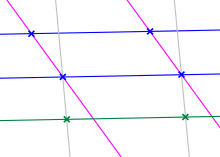
Back هندسة تآلفية Arabic Афінная геаметрыя Byelorussian Афінная геамэтрыя BE-X-OLD Афинна геометрия Bulgarian Geometria afí Catalan Afinní geometrie Czech Affine Geometrie German Ομοπαραλληλική γεωμετρία Greek Geometría afín Spanish هندسه آفین Persian

| Geometry |
|---|
 |
| Geometers |
In mathematics, affine geometry is what remains of Euclidean geometry when ignoring (mathematicians often say "forgetting"[1][2]) the metric notions of distance and angle.
As the notion of parallel lines is one of the main properties that is independent of any metric, affine geometry is often considered as the study of parallel lines. Therefore, Playfair's axiom (Given a line L and a point P not on L, there is exactly one line parallel to L that passes through P.) is fundamental in affine geometry. Comparisons of figures in affine geometry are made with affine transformations, which are mappings that preserve alignment of points and parallelism of lines.
Affine geometry can be developed in two ways that are essentially equivalent.[3]
In synthetic geometry, an affine space is a set of points to which is associated a set of lines, which satisfy some axioms (such as Playfair's axiom).
Affine geometry can also be developed on the basis of linear algebra. In this context an affine space is a set of points equipped with a set of transformations (that is bijective mappings), the translations, which forms a vector space (over a given field, commonly the real numbers), and such that for any given ordered pair of points there is a unique translation sending the first point to the second; the composition of two translations is their sum in the vector space of the translations.
In more concrete terms, this amounts to having an operation that associates to any ordered pair of points a vector and another operation that allows translation of a point by a vector to give another point; these operations are required to satisfy a number of axioms (notably that two successive translations have the effect of translation by the sum vector). By choosing any point as "origin", the points are in one-to-one correspondence with the vectors, but there is no preferred choice for the origin; thus an affine space may be viewed as obtained from its associated vector space by "forgetting" the origin (zero vector).
The idea of forgetting the metric can be applied in the theory of manifolds. That is developed in the article on the affine connection.
- ^ Berger, Marcel (1987), Geometry I, Berlin: Springer, ISBN 3-540-11658-3
- ^ See also forgetful functor.
- ^ Artin, Emil (1988), Geometric Algebra, Wiley Classics Library, New York: John Wiley & Sons Inc., pp. x+214, doi:10.1002/9781118164518, ISBN 0-471-60839-4, MR 1009557 (Reprint of the 1957 original; A Wiley-Interscience Publication)